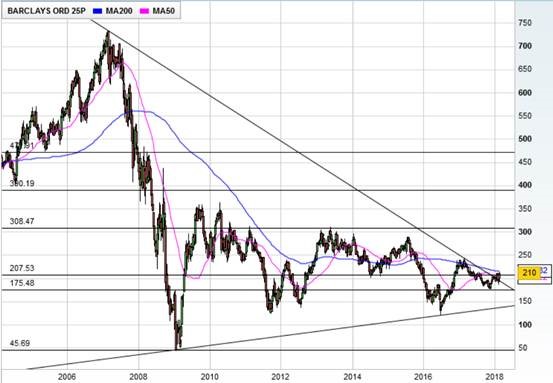Barclays becomes dividend play
22nd February 2018 15:13
by Graeme Evans from interactive investor
Share on
Perhaps mindful that has a reputation as a 'jam tomorrow' stock, chief executive Jes Staley sought to give investors a little of what they craved today.
His guidance that the dividend for 2018 will be restored to where it was two years ago helped offset any disappointment over weaker-than-expected underlying profits in annual results, particularly in light of the 14% slide in shares over the past year.
As a result, the blue-chip stock jumped 5% to test levels last seen in May. Having told investors last summer that it wouldn't be long before shareholders could finally plug into "the full earnings power" of Barclays, Staley really needed that promise of a chunky dividend hike.
The total pay-out had been cut to 3p from 6.5p in 2016 in order to pay for restructuring as Barclays retrenched back to core markets in the UK and United States, ran down non-core assets and reduced its majority shareholding in Africa.
This work to reshape the business is starting to have a positive impact on its CET1 capital ratio, which now stands at 13.3% and is comfortably within its target range.

While Barclays still has a few legacy conduct issues to address, Staley said it was the bank's intention to return a greater proportion of this excess capital to shareholders, including through share buy-backs.
Yesterday, said it would release £1 billion through a planned buy-back this year, as part of capital returns worth £3.2 billion.
Why Lloyds Bank is a 'core portfolio essential'
UBS said the promised 2018 dividend from Barclays amounted to a running yield of 3.5%, which it expects will grow slowly as any excess capital is returned through buy-backs.
Analyst Jason Napier, who had a price target of 225p prior to today's results, said the current market valuation suggests there's little in the price for management achieving their 9% and 10% targets for return on tangible equity (ROTE) in 2019 and 2020 respectively.
He added: "Once clarity is had on one-off items in head office and the outlook for these, we think the market will focus on Barclays attractive valuation and improving return profile."
The ROTE figure was 5.6% last year, but when including a raft of one-off items the ratio was a negative 3.6% after a bottom-line loss of £1.9 billion in 2017. In a reminder of the uncertainties still facing Barclays, the amount set aside to cover litigation and conduct issues, including PPI, amounted to £1.2 billion.
There was also a loss of £252 million for the corporate and investment bank in the final quarter of 2017 after revenues fell by 11%. But Staley indicated that there had been a much better start to this year, with the markets business benefiting from an increase in stock market volatility.
These articles are provided for information purposes only. Occasionally, an opinion about whether to buy or sell a specific investment may be provided by third parties. The content is not intended to be a personal recommendation to buy or sell any financial instrument or product, or to adopt any investment strategy as it is not provided based on an assessment of your investing knowledge and experience, your financial situation or your investment objectives. The value of your investments, and the income derived from them, may go down as well as up. You may not get back all the money that you invest. The investments referred to in this article may not be suitable for all investors, and if in doubt, an investor should seek advice from a qualified investment adviser.
Full performance can be found on the company or index summary page on the interactive investor website. Simply click on the company's or index name highlighted in the article.